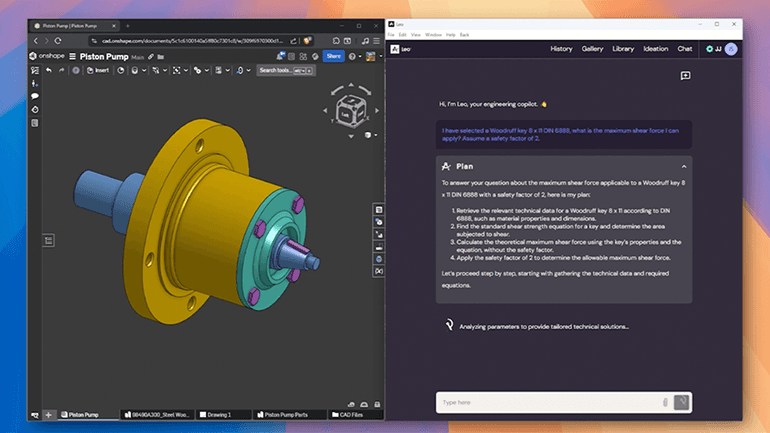Dr. Maor Farid, Co-Founder & CEO at Leo AI
Aug 16, 2025
The Hidden Time Sink in Mechanical Engineering
Most mechanical engineers don’t spend the majority of their time designing and building products in CAD - they spend it figuring out exactly what to design.
That often means:
Calculating the maximum stress on a part
Determining the minimum bolt diameter to prevent failure
Performing engineering calculations for thermal expansion, fatigue, or material properties
Traditionally, this process involves:
Searching through engineering references like Shigley’s Mechanical Engineering Design or Machinery’s Handbook
Scrolling to find the right formula
Opening Excel or MATLAB to run the calculations
Substituting values, double-checking units, and hoping nothing was missed
Even after all that, engineers still ask themselves: Did I use the right formula? Did I account for every condition?
Introducing Leo AI - Your AI for Engineering
Now, you can simply use Leo AI to describe your engineering problem. Leo will:
Find the exact formulas you need from over 1 million engineering references
Show you the exact page in the right book - no endless scrolling
Run the calculations for you and share the code for full transparency
Prompt you for missing parameters so no details are overlooked
AI for CAD: Understanding Geometry Without Words
For certain CAD tools where Leo is already integrated, it can even interpret part geometry directly - so you don’t have to describe it in words. This means:
Faster CAD search and part selection
Fewer errors when translating designs into calculations
A seamless engineering workflow from model to result
What’s Next for Leo AI
PLM Integration Expansion - Leo will soon connect with more PLM systems and use your organization’s internal documents, guidelines, and rules of thumb - applying your specific methods, not just industry standards.
CAD Awareness - Recently announced Onshape by PTC integration, with more CAD tools on the way, enabling Leo to answer engineering queries directly from your designs.
Why Mechanical Engineers Should Care
By removing the friction in engineering formula search and calculation automation, Leo AI:
Saves hours - of manual search
Reduces the risk of calculation errors
Unlocks hidden value in both public and internal engineering knowledge
Bridges the gap between design intent and CAD execution
Try Leo AI Today
Try Leo AI for free or book a demo.
Let’s build better products, faster - together.
Frequently Asked Questions (FAQ)
1. What types of engineering problems can Leo AI solve?
Leo AI helps with a wide range of mechanical engineering challenges, including stress analysis, bolt sizing, thermal expansion, fatigue, and material property calculations. It streamlines the process of finding formulas, running calculations, and verifying results.
2. How accurate is Leo AI when solving engineering problems?
Leo AI delivers up to 96% accuracy when solving engineering problems. It uses trusted references and validated formulas to ensure reliable outcomes.
3. Where does Leo AI get its formulas and data from?
Leo AI searches through over 1 million trusted engineering references such as Shigley’s Mechanical Engineering Design and Machinery’s Handbook, instantly identifying the correct formula and even showing the exact page.
4. Can Leo AI run engineering calculations for me?
Yes. Leo not only finds the correct formulas, but also runs the full calculations, shares the code behind the results, and prompts you for any missing parameters to ensure nothing is overlooked.
5. How does Leo AI integrate with CAD tools?
For supported CAD environments like Onshape, Leo AI can interpret part geometry directly, allowing engineers to skip manual descriptions. It enables faster CAD search, fewer translation errors, and smoother workflows from design to analysis.
6. Will Leo AI support PLM systems and internal engineering rules?
Yes. Leo is expanding to integrate with more PLM systems and apply your organization's internal guidelines, design rules, and best practices—not just industry standards.
7. Why should mechanical engineers consider using Leo AI?
Leo AI saves hour
Ready to try Leo? Try Leo Today
Enjoyed this article on Solve Engineering Problems in Seconds - With 96% Accuracy 🚀 - Leo - Generative AI for Engineering CAD Design? Don’t miss Win a $50 Amazon gift card by sharing your work with Leo 🎁 - Leo - Generative AI for Engineering CAD Design






